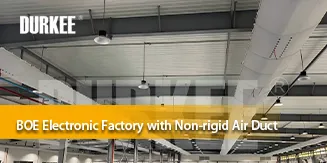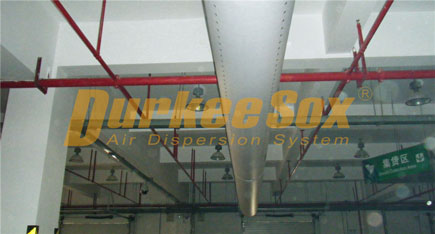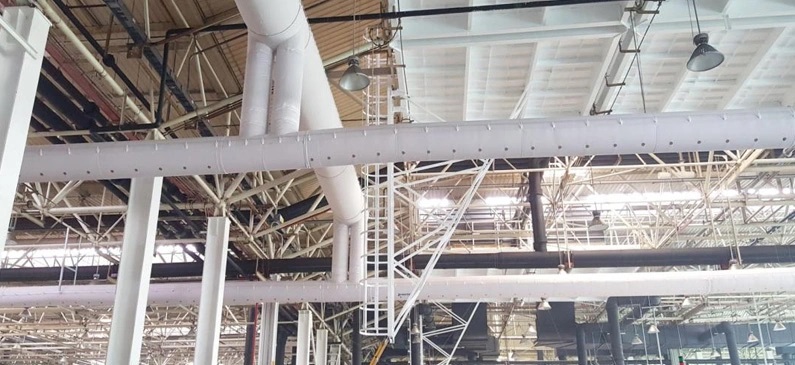 BOE Vietnam Factory: Non-rigid Air Duct Solutions for Electronic Industry
BOE Vietnam Factory: Non-rigid Air Duct Solutions for Electronic Industry
 Why Fabric Air Ducts Are the Preferred Choice for Ventilation in Large Spaces
Why Fabric Air Ducts Are the Preferred Choice for Ventilation in Large Spaces
 The Difference Between Non-Rigid Air Ducts and Rigid Ductwork
The Difference Between Non-Rigid Air Ducts and Rigid Ductwork
In the realm of HVAC (Heating, Ventilation, and Air Conditioning) systems, choosing the right air ducting solution is crucial for ensuring optimal indoor air quality (IAQ) and operational efficiency. Historically, traditional metal ducts have been the go-to choice for many construction projects. However, fabric ducts are increasingly being recognized for their numerous benefits. This article provides a detailed comparison of fabric ducting to metal ducting, highlighting key advantages.
Fabric Ducts: Typically made from polyester, fabric air ducts are designed to withstand harsh conditions while offering long-lasting performance. Contrary to common assumptions, fabric ductwork often outlasts its metal counterparts. Their ability to handle high-humidity environments without deteriorating makes them a robust choice for various applications. Additionally, fabric air ducts reduce the load on building structures, contributing to overall structural efficiency.
Metal Ducts: Traditionally constructed from steel or galvanized steel, metal ducting is perceived as more durable. However, in high-humidity settings, traditional sheet metal ductwork is prone to rust and corrosion. The condensation that forms on metal surfaces accelerates degradation, potentially compromising the structural integrity of the ductwork and posing health risks due to rust particles and corrosion products.
Fabric Ducts: One of the standout features of fabric air ducts is their resistance to corrosion and rust. Fabric ductwork that is exclusive-owned and patented micro-permeable prevents condensation by letting air pass through the fabric. This property eliminates the need for special coatings and reduces maintenance requirements, effectively safeguarding against corrosion and rust.
Metal Ducts: Metal ducts require periodic maintenance to prevent rust and corrosion, particularly in environments with high humidity. Rust can not only damage the metal sheet ductwork but also affect the surrounding structural supports, creating potential safety hazards.
Fabric Ducts: The lightweight and flexible nature of fabric ducting significantly reduces transportation and installation costs. They are shipped in compact packages, which can be easily handled by standard parcel services. Installation is straightforward, requiring only on-site assembly of finished modules. This simplicity allows installation to be completed in a fraction of the time needed for metal air ducts.
Metal Ducts: In contrast, galvanized sheet metal ducting is bulky and heavy, necessitating large commercial vehicles for transport. Installation demands specialized tools, heavy machinery, and a team of trained professionals. The process is time-consuming and can extend over several weeks, often requiring additional structural and seismic considerations.
Fabric Ducts: The total cost of fabric air duct HVAC systems can be significantly lower than that of metal ducts. Estimates suggest that fabric ducts can save up to 30% in initial costs compared to metal ducts. When factoring in transportation, installation, and maintenance, the overall savings can reach up to 70%. This makes fabric ductwork a cost-effective HVAC air duct solution, particularly in projects with tight budgets or where high material costs impact pricing.
Metal Ducts: While metal ducting may have a lower initial cost in some cases, the additional expenses related to transportation, installation, and ongoing maintenance can make them more costly in the long run.
Fabric Ducts: The versatility of fabric ducting is enhanced by their advanced properties, including antimicrobial and fire-resistant features. They are suitable for a wide range of applications, from sports complexes and food processing facilities to laboratories and retail spaces. Moreover, flexible air ducts can be customized with various colors and patterns, enhancing aesthetic appeal and integrating seamlessly with interior designs.
Metal Ducts: traditional metal ducting is generally more static in its applications and does not offer the same level of customization or innovative features. While they are reliable, their applications are often limited by their design and material properties.
Fabric Ducts: Currently, flexible air ducts represent approximately 10% of the global HVAC ductwork market, with a growing demand each year. This increasing adoption reflects their rising popularity and recognition as a viable alternative to traditional metal ducts.
Metal Ducts: Despite their long-standing presence in the market, metal ducts face growing competition from fabric ducting, especially in sectors where cost-efficiency and flexibility are critical.
Fabric ducts offer a range of advantages over traditional metal ducts, from enhanced durability and corrosion resistance to lower installation and maintenance costs. Their versatility and innovative features make them a compelling choice for various applications. By considering the benefits outlined in this analysis, stakeholders can make informed decisions that align with both their operational needs and budgetary constraints.
Request a free consultation with a fabric duct expert.